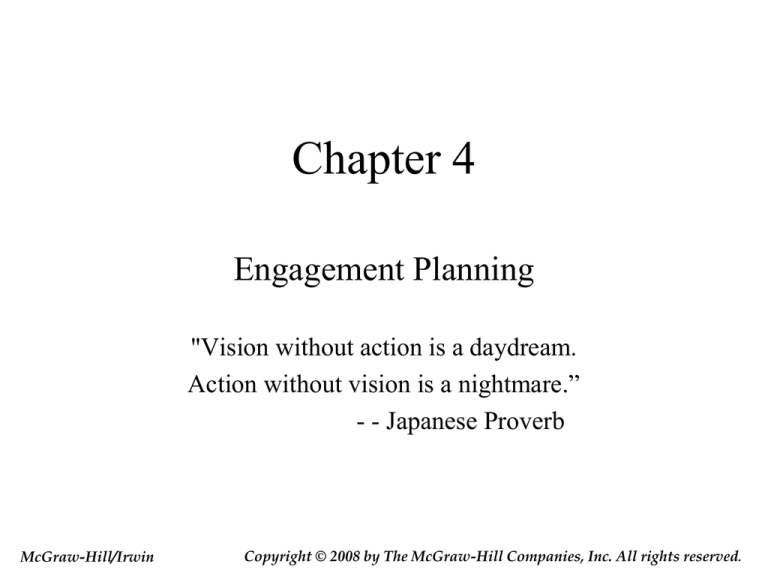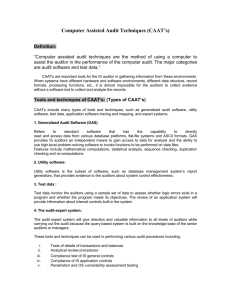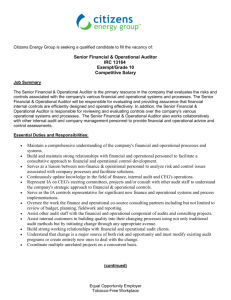
Chapter 4
Engagement Planning
"Vision without action is a daydream.
Action without vision is a nightmare.”
- - Japanese Proverb
McGraw-Hill/Irwin
Copyright © 2008 by The McGraw-Hill Companies, Inc. All rights reserved.
4-2
Goals of Planning
• Obtain (or update) an
understanding of important
events that have affected the
client and its operations
• Identify areas of the engagement
that may represent special risks
to the public accounting firm.
• Ensure that the engagement can
be completed in a timely fashion
4-3
Pre-Engagement Arrangements
• Client selection and
retention
• Communication
between predecessor
and successor auditors
• Engagement letters
• Staff assignment
• Time budget
4-4
Communication between Predecessor and
Successor Auditors (SAS 84)
• Attempt to communicate required
• If client permits, issues to discuss
– Disagreements about accounting principles or audit
procedures.
– Communications the predecessor auditors gave the
former client about fraud, illegal acts, and internal
control recommendations.
– The predecessor auditors’ understanding about the
reasons for the change of auditors (particularly about
the predecessor auditors’ termination).
4-5
Understanding the Client’s Business
• Methods and sources of information
– Inquiry, including prior year working
papers
– Observation
– Study
• Other aspects of planning
–
–
–
–
–
–
Materiality and planning
First-time audits
Internal auditors
Identification of related parties
Specialists
Analytic procedures
4-6
Enterprise Risk Management Framework
Monitoring
Internal Environment
Objective
Setting
Event
Identification
Risk
Assessment
Risk
Response
Control
Procedures
Information
and
Communication
4-7
Planning Memorandum
• Summary of planning procedures
• Considerations
1. Investigation or review of the prospective or continuing client
relationship.
2. Provision of special services or reports and needs for special
technical or industry expertise.
3. Staff assignment and timing schedules.
4. Assessed level of control risk.
5. Significant industry or company risks.
6. Computer system control environment.
7. Utilization of the company’s internal auditors.
8. Identification of unusual accounting principles problems.
9. Schedules of work periods, meeting dates with client personnel,
and completion dates.
• Basis for audit program
4-8
Preliminary Analytic Procedures (SAS 56)
RECORDED
ACCOUNT
BALANCE
ESTIMATED
ACCOUNT
BALANCE
• Attention directing
– Identify potential problem areas
• An organized approach
– A standard starting place to start examining the financial statements
• Describe the financial activities
– Identify unusual changes in relationships in the data
• Ask relevant questions
– What could be wrong?
– What legitimate reasons are there for these results?
• Cash flow analysis
4-9
Analytic Procedure Steps
1. Develop an expectation.
2. Define a significant difference.
3. Calculate predictions and compare them
with the recorded amount.
4. Investigate significant differences.
5. Document each of the above steps.
4-10
Analytic Procedures:
Sources of Information
Analytic Procedures
Sources of Information
Comparison of current-year account balances Financial account information for
to those of one or more comparable periods
comparable periods.
Comparison of the current-year account
balances to anticipated results found in the
company’s budgets and forecasts.
Company budgets and forecasts.
Evaluation of the relationships of currentyear balances to other current-year balances
for conformity with predicable patterns
based on the company’s experience.
Financial relationships among accounts in
the current period (ratios).
Comparison of the current-year account
balances and ratios with similar industry
information.
Industry statistics.
Study of the relationships of current-year
balances with relevant nonfinancial
information (e.g., production statistics).
Nonfinancial information, such as
production statistics.
4-11
Analytic Procedures:
Stages of Use
• Preliminary planning-- required
• Substantive testing -- optional
• Final review -- required
4-12
Effect of Electronic Environment
on Audit Engagement
• The definition of auditing is not changed.
• The purposes of auditing are not changed.
• The generally accepted auditing standards are not
changed.
• The assertions of management embodied in
financial statements are not changed.
• The requirement to gather sufficient competent
evidence is not changed.
• The independent auditor's report on financial
statements is not changed.
4-13
What has changed?
• The auditor must evaluate the impact of
technology on the client’s operations.
• The auditor must evaluate computer
controls implemented by the client in the
auditor’s study and evaluation of the
client’s internal controls.
• The auditor can use the computer’s speed
and accuracy to assist in the audit.
4-14
Effect of Computer Processing on
Transactions
•
•
•
•
•
Transaction trails
Uniform processing of transactions
Segregation of duties
Potential for fraud
Potential for increased management
supervision
• Initiation or subsequent execution of
transactions by computer
4-15
Planning considerations
• Extent to which computers are used
• Complexity of computer operations
• Organizational structure of computer
processing
• Availability of data
• Use of CAATs- the use of software to perform
audit procedures
• Need for specialized skills
4-16
Computer Assisted Audit Tools and
Techniques (CAATs)
• With CAATS, the auditor is able to access and extract client
information without disrupting data processing.
• Some CAATs Procedures:
– Calculate field statistics (totals, high, low and average
value)
– Perform complex recalculations
– Join, concantenate and compare different files
– Perform detailed analysis
• Stratification
• Gap and duplicate key detection
• Sample selection
4-17
Audit Documentation (AS 3)
• Definition
– The written record of the basis for the auditor’s conclusions that
provides the support for the auditor's representations, whether
those representations are contained in the auditor's report or
otherwise.
• Objectives
– Improve audit quality
– Enhance public confidence
• Contents
–
–
–
–
Planning and performance of the work
Procedures performed
Evidence obtained
Conclusions reached by the auditor
4-18
Purposes of Audit Documentation
• Integral part of audit quality
• Documents the nature, timing and extent of
work performed
• Evidence of due professional care
• Basis for conclusion
• Facilitates planning, performance and
supervision
• Provides basis for review
4-19
Audit Documentation Files
• Current files
• Permanent files
• Prior year files
Exhibit 4.6
Current Audit Documentation File
4-20
4-21
Exhibit 4.7
Illustrative Audit Documentation
• Information on Workpaper
Insert Exhibit
4.7
– Name, date, purpose, page
number
– Procedures performed and
conclusions reached by the
auditor
• Evidence that auditor
followed general standards
and standards of field
work
• Audit Mark Legend
– Reviewers’ initials
4-22
Audit Documentation Requirements
• Audit documentation should be prepared in sufficient
detail to enable an experienced auditor having no
previous connection with the engagement to:
– Understand the nature timing, extent and results of procedures,
evidence obtained and conclusions reached.
– Determine who performed the work, date of work, reviewer and
date of review.
• Audit documentation should provide a clear link to
significant findings or issues and
– Demonstrate compliance with PCAOB standards.
– Support basis for conclusions on every relevant assertion.
– Document that accounting records agree with financial statements.
4-23
Significant Findings or Issues
• Selection, application and consistency of accounting
principles, including disclosures
• Results of procedures that indicate need for significant
modification of procedures, existence of material
misstatements, significant deficiencies in controls
• Audit adjustments
• Disagreements
• Circumstances that cause significant difficulty
• Significant changes in assessed audit risk
• Matters that could result in report modification
4-24
Specific Audit Documentation Matters
• Should include identification of items inspected, confirmed
or tested.
– Satisfied by indicating source and selection criteria.
• Documentation of inspected agreements should include
abstracts or copies.
• Should include contradictory information found
– Information the auditor has identified relating to significant
findings or issues that is inconsistent with or contradicts the
auditor’s final conclusions.
– Procedures performed in response.
– Records documenting consultation on or resolutions of differences
among team and with others consulted.
4-25
Engagement Completion Document (AS 3)
• Must include all significant findings or issues.
• Must include items identified during interim review.
• Must have completed all necessary procedures and
obtained sufficient evidence before report release
date.
• Documentation should be complete (documentation
completion date) no more than 45 days after report
release date.
4-26
Documentation Retention (AS 3)
• Documentation must be retained seven years from
report release date.
– If no report—from last day of fieldwork
• Additions/Amendments
– Documentation may not be deleted or discarded after
report release date.
– Additions must indicate
• Date the information was added
• Name of preparer
• Reason
4-27
Specific Documentation Retention
Requirements (AS 3)
• Issuing office must retain
prior to report release date
– Engagement completion
document
– List of significant fraud risk
factors, responses and
results of related procedures
– Inconsistent or
contradictory information
– Finding affecting
consolidating or combining
of accounts
– Information to reconcile
amounts audited by other
auditors to consolidated
financial statements
– Schedule of audit
adjustments
– All significant control
deficiencies and material
weakness and clear
distinction between
categories
– Representation letters
– Matters to be
communicated to audit
committee
4-28
Audit Documentation Review
• Hierarchical review process
• Reviewers include
–
–
–
–
–
–
New auditors
Supervisory personnel
Engagement supervisors and quality reviewers
Successor auditor
Inspection teams
Others including advisors engaged by the audit
committee or parties to an acquisition
4-29
Other Issues Related to
Audit Documentation
• Ownership
– Auditors maintain ownership, even after auditor-client
relationship is over.
• Confidentiality
– Only can be made public with permission, or if subpoenaed, or
as part of a peer review of firm practices, or as part of an
ethics investigation of firm personnel.







